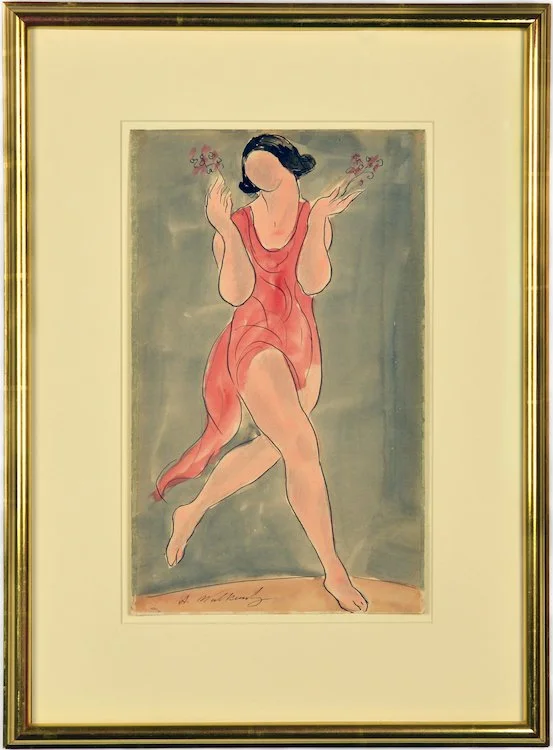Perpetual Motion: Abraham Walkowitz Draws Isadora Duncan
March 7 - June 24, 2022
Abraham Walkowitz (American, 1878-1965), Isadora Duncan (with roses), watercolor, pen, ink, and graphite on paper, 14 x 8 1/2 inches. Photograph courtesy of Madron Gallery.
Chicago, IL - What is the power of a line, of ink and graphite sinking into a piece of paper? The simple, gestural figure drawings created by modernist Abraham Walkowitz (American, b. Russia, 1878–1965) of the modern dancer Isadora Duncan (American, 1878–1927) answer this question many times over. A confident black line sweeps across the paper, creating the sensation of movement with its bends and curves, its variations in boldness and width. The line elongates and combines with others, forming a figure clad in a sheer tunic, head raised, arms and legs stretching across the wide expanse, challenging the borders of the page.
Madron Gallery’s Perpetual Motion explores the natural inclination of disparate artists and art forms to intertwine, inspire, and transform one another. Twelve of Walkowitz's original drawings are exhibited alongside a filmed 2016 performance of Varshavianka, a work Duncan choreographed in 1924. The piece was presented by the Department of Fine and Performing Arts at Loyola University Chicago; it was staged and coached by Jennifer Sprowl of Duncan Dance Chicago, who is both a professional dancer and Duncan historian. In keeping with the spirit of 2022 as the #YearofChicagoDance, Sprowl will give a live demonstration and talk on Duncan at Madron Gallery this June 12th, at 2:00 PM.
Abraham Walkowitz and Isadora Duncan were contemporaries, born in the same year and raised on opposite sides of the country. They met for the first time in 1906, in the Paris studio of Auguste Rodin (French, 1840–1917). They would meet again while Duncan was touring the United States in 1908, 1909, 1915, and 1916. It is estimated Walkowitz created over 5,000 drawings of Isadora Duncan throughout the course of his career, endeavoring to capture the essence of Duncan’s movement. Much like her own character, the gestures and rhythms of modern dance Duncan forged were a force of nature. Walkowitz said of Duncan, “She has no laws. She didn’t dance according to the rules. She created. Her body was music. It was a body electric.” Though the sheer volume of Walkowitz’s drawings speaks to an obsessive desire to preserve precisely the spirit of Duncan's motion, the end result feels as spontaneous as the subject herself.
Abraham Walkowitz was born in Siberia, Russia and emigrated to America in 1883. He studied at the National Academy of Design, NY and the Académie Julian in Paris. An early modernist painter known for abstract figurative works and cityscapes of New York, he exhibited in the 1913 Armory Show, was a member of Alfred Steiglitz’s inner circle, and regularly exhibited at 291 Gallery until its close in 1917. His artwork can be found in numerous museums and private collections, including The Whitney Museum, NY; The Museum of Modern Art, NY; The Metropolitan Museum, NY; The Jerome Robbins Dance Division, New York Public Library; The Brooklyn Museum, NY; The Phillips Collection, D.C.; and the Smithsonian American Art Museum.
Isadora Duncan was born in San Francisco, the youngest child in an artistic and unconventional family. Duncan’s travels began with a move to Chicago, then New York, before moving to London in 1898. There she began performing in the drawing rooms of the wealthy, taking inspiration from the Greek vases and bas-reliefs held in The British Museum. Duncan created a form of dance based on the organic motions and rhythms of the natural world, in contrast to the rigidity of ballet. Known as “The Mother of Modern Dance,” Duncan’s influence spread across America, Europe, and Russia where she toured and opened schools to teach young women her philosophy of dance. Duncan championed the notion of free-spiritedness coupled with the high ideals of ancient Greece: beauty, philosophy, and humanity. In addition to Walkowitz, Auguste Rodin, Gertrude Stein (American, 1874–1946), John Sloan (American, 1871–1951), and Edward Steichen (American, 1879–1973) are among the artists who created drawings, sculptures, poetry, and photography inspired by Duncan and her dance. Isadora Duncan died infamously in France while riding as a passenger in an open car – her long scarf got caught in the rear axle and broke her neck.
Founded in 2008, Duncan Dance Chicago fosters the education and appreciation of Isadora Duncan’s dance art technique through classes, performances, workshops, and community outreach. Artistic Director Jennifer Sprowl is also a founding member of the Isadora Duncan International Symposium, a teaching artist at the Joffrey Academy, and a faculty member at the Chicago Movement Collective. Sprowl was a principal dancer of the Isadora Duncan Dance Company in NYC and trained directly with Duncan dance luminaries Hortense Kooluris (1914–2007), Julia Levien (1911–2006), and Lori Belilove; all of whose education and training in the Duncan method can be traced back to Isadora Duncan. Sprowl and Duncan Dance Chicago performed in 2019 at the Isadora Duncan International Symposium, London, UK.
Madron Gallery’s inventory of paintings, drawings, sculptures, photographs, and prints showcases the breadth and depth of art in the United States from the late 19th century on. Known for its American Impressionist pieces, Madron also features an outstanding and constantly growing collection of modern and contemporary art, aiming to illuminate artistic connections across decades and centuries.
